
We release the statement from Independent SAGE, unedited and in full below:
The pandemic in England is now at the most threatening stage of the entire year. The number of cases are at the highest they have been since the start of community testing in May, with over 40,000 people testing positive each day in the couple of days before Christmas. [slide 1]:
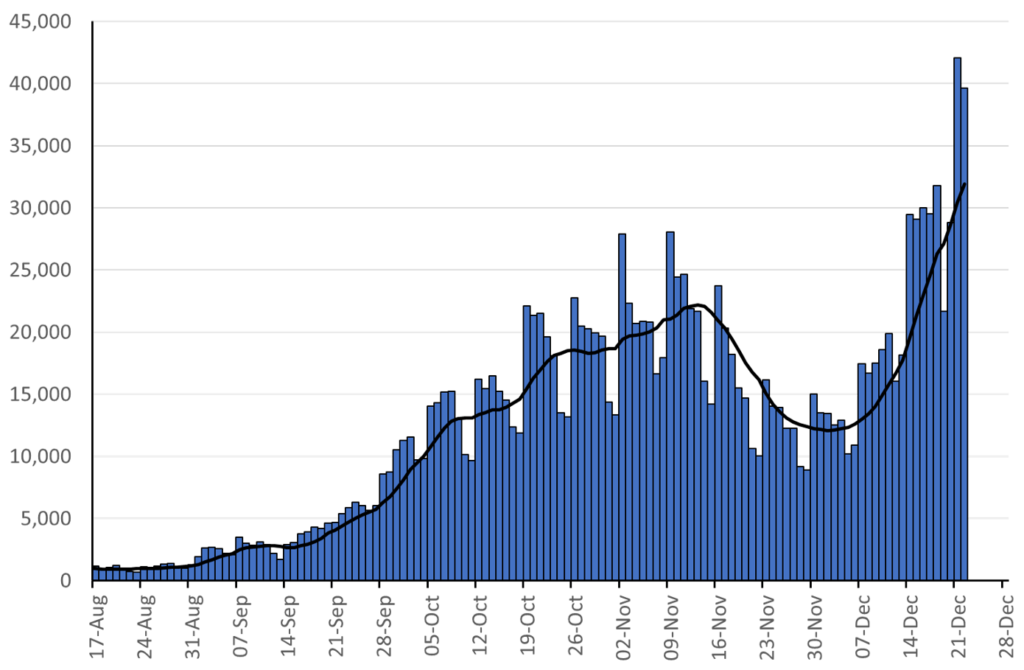
There are now more people in hospital (20,426 as at 28th December) with Covid-19 than at any point during the pandemic [slide 2]. Admissions each day are still rising (over 2,200 on Boxing Day). With cases still rising steeply, pressures on the NHS in England will get significantly worse over the next few weeks.
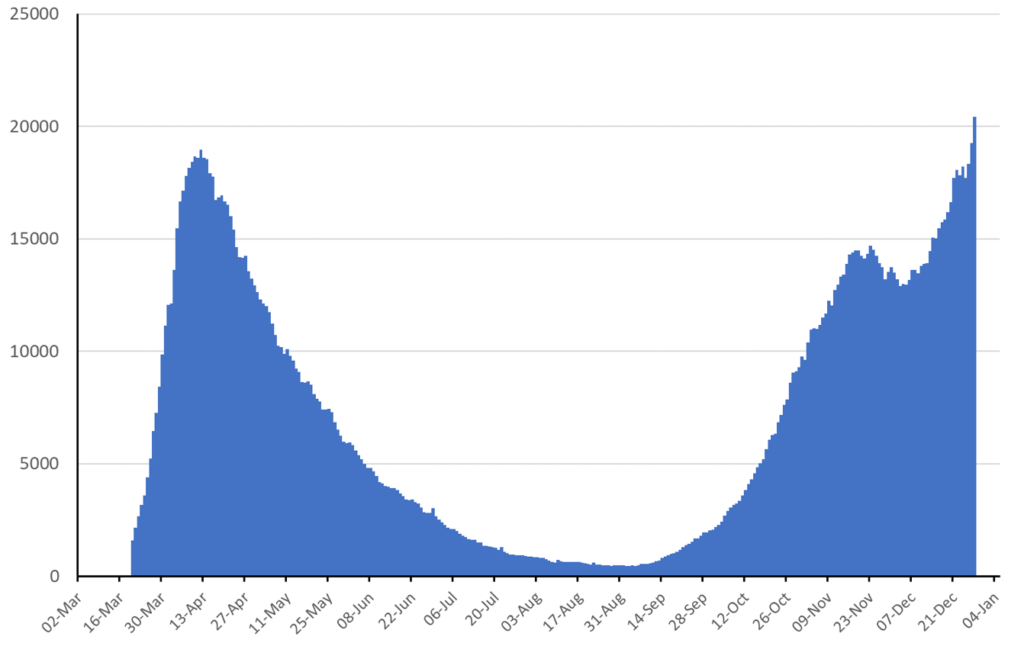
Over 27,000 people have died within 28 days of a positive Covid-19 test since September, compared to almost 37,000 from March to August this year. [slide 3]. There were over 3,000 deaths in the last week alone, reflecting people infected at the beginning of December. Since then, cases have almost tripled and hospital admissions almost doubled. This means that the number of deaths will, unfortunately, increase and keep increasing for several weeks yet. Deaths from the second wave will probably exceed those in the first wave at some point in January.
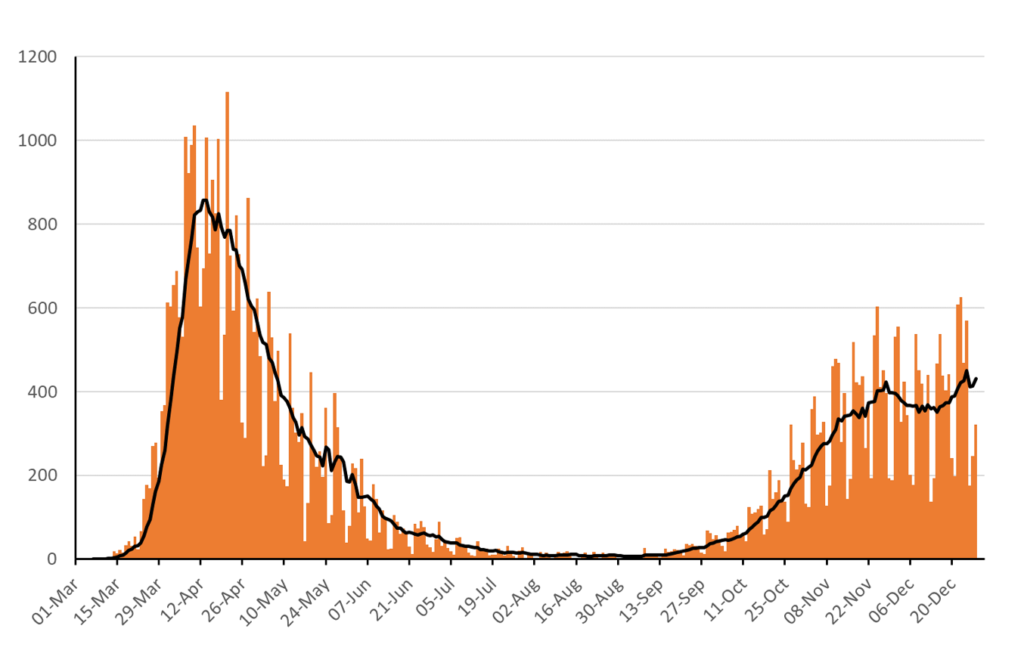
Failure to implement a circuit breaker, recommended by SAGE and Independent SAGE at the end of September, resulted in a delayed a lockdown until November. As a result, a new variant of Covid-19 (B117), since shown to be more transmissible, was given the opportunity to spread widely, particularly in the East, South East and South Wales. It also meant that England entered December with a high number of cases, despite lockdown, and a high number of people in hospital.
The new variant has come to rapidly dominate cases in London, the South East and East of England [slide 4], but it is present in all regions. The SAGE modelling subgroup believe that by mid-January the new variant will be the dominant strain across the whole of England.

The greater transmissibility of B117 has tipped us into a new, even more serious, pandemic. We are no longer in the same pandemic we were in up to December. The very rapid rise of cases in London, the South East and East of England [slide 5] under restrictions that previously kept growth much slower, highlights the need for a radical rethink of how we deal with Covid-19 going forward. The existing tier system in England is simply not sufficient, even where the new variant is rare. Cases are increasing, albeit more slowly, across all English regions [slide 5]. If, as anticipated, the new variant takes hold across the country, transmission will increase in all areas.
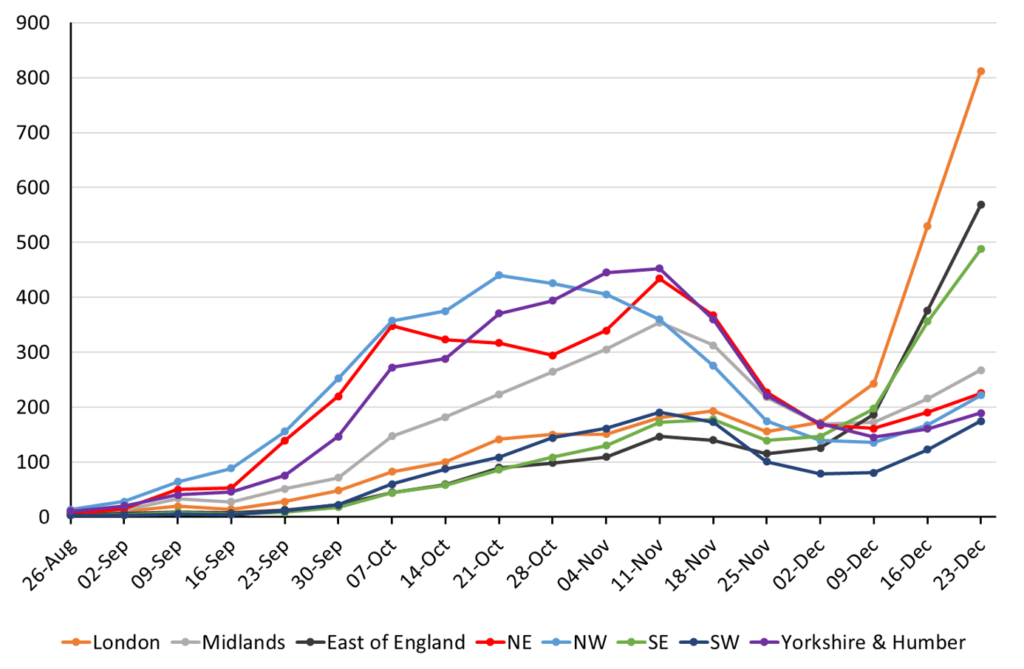
While the new variant is not thought to cause more severe disease than the standard strain of Covid-19, its greater infectiousness will inevitably lead to many more hospitalisations [slide 6] and deaths as more people catch it. The regions where B117 is prevalent, most notably London, have seen a much more rapid rise in hospital admissions than other regions and London now has by far the highest admission rates in the country.
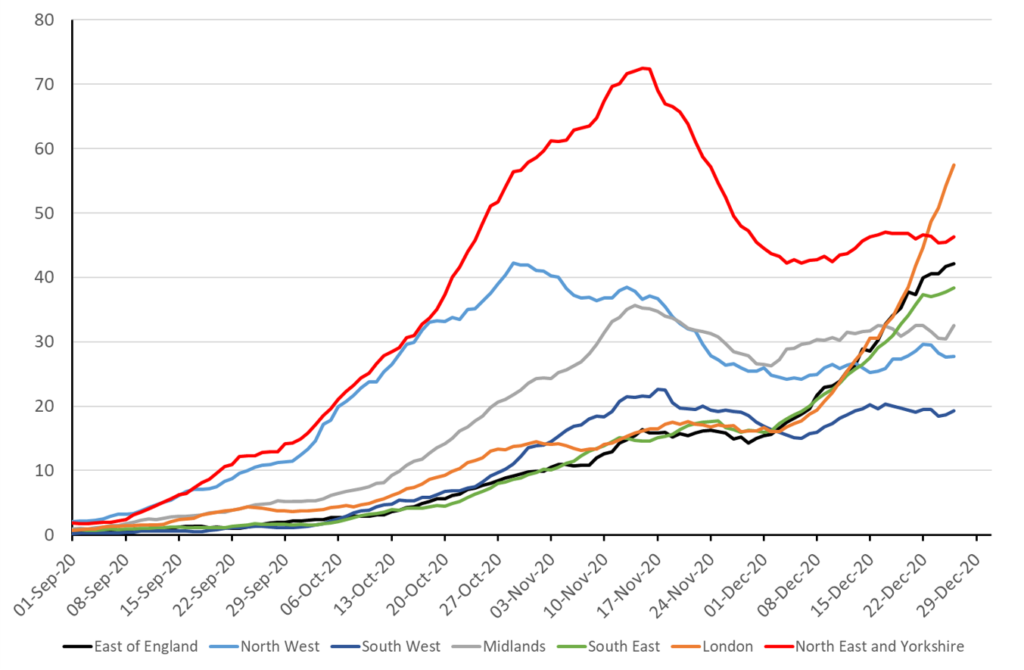
On Boxing Day, several local authorities were allocated to a higher tier, with all of the South East of England now in Tier 4 (highest level) and most of the Midlands and much of the North in Tier 3. Matt Hancock acknowledged that Tiers 2 and 3 are not enough to suppress the new variant. They seem not enough to suppress the standard strain either as cases in Tier 3 and Tier 2 areas have been steadily increasing since the beginning of December [slide 7]. Cases in current Tier 2 areas have more than doubled since the end of Lockdown on 2nd December. Cases in current Tier 3 areas have grown by 40% in the same time period.
Meanwhile, cases in current Tier 4 areas have quadrupled since lockdown and – so far – show no sign of slowing down [slide 7]. It is now over 10 days since Tier 4 was imposed on London, Kent and parts of East England. If cases in these areas do not level and reduce soon, then we cannot expect Tier 4 to be enough to contain Covid-19 in England.
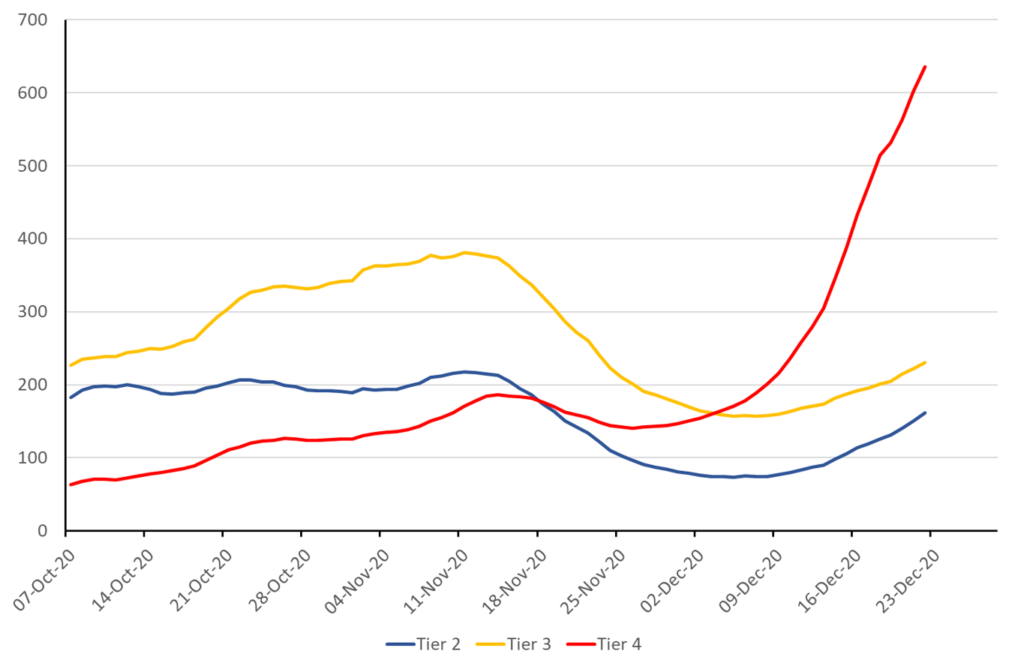
With a highly effective vaccine being rolled out, with more vaccines to be approved shortly, it is unconscionable that Covid-19 be allowed to run rampant through our communities just when protection is on the horizon. We urgently need a new plan to control Covid-19 into 2021 and aggressively drive down cases across England.
Delayed and tentative decision making will result in the deaths of tens of thousands more people. Modellers from the SAGE modelling subgroup estimate that even under national Tier 4, another 100,000 people could die before the end of June 2021. In that scenario, hundreds of thousands others would go on to suffer long term effects from Covid-19 and the NHS would be brought to its knees. The government needs to act now to prevent this catastrophe.
We strongly urge that the following strategy be adopted immediately.
-
A nationwide lockdown with immediate effect is vitally necessary now.
-
Schools contribute to the increasing transmission (R rate). We all want staff and children in schools safely, but sadly that is not an option now for at least a month. The unprecedented crisis requires Government immediately provide digital access for all children, recruiting retired teachers and others to help provide excellent online teaching, enabling children who can’t work from home to attend school along with vulnerable and key worker children. The Government should use January to make schools safe, e.g. extra space from unused buildings to enable 2 metre distancing, free masks and encourage all to wear them, multiple sanitiser stations and support for improved ventilation. There should be an immediate Government taskforce, including teaching unions, local authorities, governing bodies and parents, to implement this plan.
-
There must be a clear strategy to mark the end-point of the new lockdown. This is when the number of new cases has dropped to the point where all those with the disease and in contact with them are isolated, with support where necessary, from the rest of the population. A fully operative Find, Test, Trace, Isolate and Support system must be in place through local public health services and the army, which will need appropriate funding.
-
Meanwhile, an explicit strategy for vaccine rollout is required. Current rates of immunisation, whilst a good start, are insufficient to ensure coverage of priority groups by Easter 2021. The necessary primary-care-led upscale requires new resources and staffing now. Appropriate support and messaging to all communities is required to ensure sufficient uptake to establish population immunity, and minimise death, disease and long-term physical and mental ill-health.
-
We must also support and contribute to the rapid roll out of the vaccine to low and middle income countries – the more Covid-19 is allowed to spread, the more opportunities it has to develop new mutations.
-
We must institute an effective Covid control strategy at our borders. As in other countries, personal travel, especially international travel, must be monitored and regulated effectively, with advance application for travel to and from the UK, a negative PCR test prior to travel and managed isolation on arrival.
Sir David King, chair of Independent SAGE and former Chief Scientific Adviser to the UK government: ‘The UK is now at the most precarious stage of the pandemic and urgent action is needed. The reasons for the extreme urgency and the five action points that must now be carried out by our decision makers are set out in our press briefing. There is every reason to treat this as the critical time for action NOW. Any delay will probably cause tens of thousands more deaths.’
Christina Pagel, Professor of Operational Research, University College London: ‘Things are as bad as they have ever been. The frightening thing is that they are going to continue to get worse. Action is needed now to avoid the collapse of the NHS in a few weeks. It is that serious.’
Deenan Pillay, Professor of Virology, UCL: ‘We urge the government to avoid yet again doing too little, too late to halt the latest surge of this deadly pandemic.’
